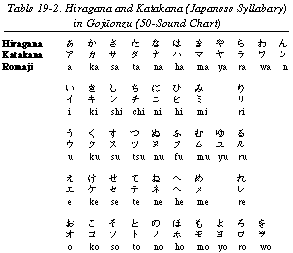Kanji were the sole form of writing used in Japan for a few hundred years after their introduction in the 4th or 5th century. ...
Kana developed out of the phonetic use of Kanji. In the early days of Kanji use, to write the names of people and places, the Japanese used Kanji for their sounds, ignoring their meanings. ...
Kanji used phonetically for their sounds, disregarding their meanings, are called Man'yoogana (Man'yoo + kana). The term Kana could come from karina (kari 'borrowed' and na 'name' or 'letter') in the sense that Kana borrow the sounds of Kanji; or the term could mean 'false letter' vis-a-vis mana ('genuine letter'), i.e., Kanji used as logographs for their meanings. Other possible meanings suggested for kari are temporary, unofficial, nonregular. Karina eventually became Kana via Kanna.

Table 19-1 shows the Kanji origin of Kana, which comes in two forms, Katakana and Hiragana. ...
Each Hiragana ('plain, common, or smooth Kana') is a graceful cursive form of its original Kanji, as shown in Table 19-1. In some cases (e.g., fu, te) the same Kanji was the source for both Hiragana and Katakana signs. Hiragana was used mainly by female authors to write letters, poems, diaries, and eventually stories. Its existence was acknowledged publically in an anthology of Japanese poems, Kokin Wakashuu (Collection of Poems Old and New), that appeared in 905. One of Japan's greatest literary works, The Tale of Genji (Genji Monogatari) by Lady Murasaki Shikibu in the early 11th century, was written in Hiragana, with only a handful of Kanji to write Chinese loan words.
Kana developed gradually, between the 8th and 9th centuries, out of Chinese characters in the following stages:
Kanji->Kanji as phonetic signs->simplified Kanji shapes ->Kana

Table 19-2 shows the 46 basic Kana--Hiragana and Katakana--that code 5 monosyllabic vowels (a, e, i, o, u), 40 consonantvowels (e.g., ka, ha) plus 1 nasal N, with their sounds indicated by Roomaji or Roman letters. ... The order of the basic Kana signs is called Gojuuonzu ('50-sound chart'), even though the number of basic Kana has fluctuated over the years between 50 and 46. It follows the order of listing phonemes used by Indian phoneticians for Sanskrit. Gojuuonzu, like the order of letters in an alphabet, is worth remembering, because it is often used in ordering words in dictionaries and telephone directories. ...
The full Kana chart would include 25 secondary Kana that code 20 voiced and 5 semi-voiced CV versions. The secondary Kana are created by adding a two-comma-like mark or a tiny circle to the top right of 25 of the basic Kana. The 36 compound Kana are created by combining 36 of the basic and and secondary Kana with any of the three small-sized Kana for ya, yo, yu.
The number of Hiragana signs varies, depending on which kinds are included in the count.
Katakana, being an alternate form of Kana, has the same number of signs as Hiragana. It also has some extra signs in order to transcribe foreign words. ...